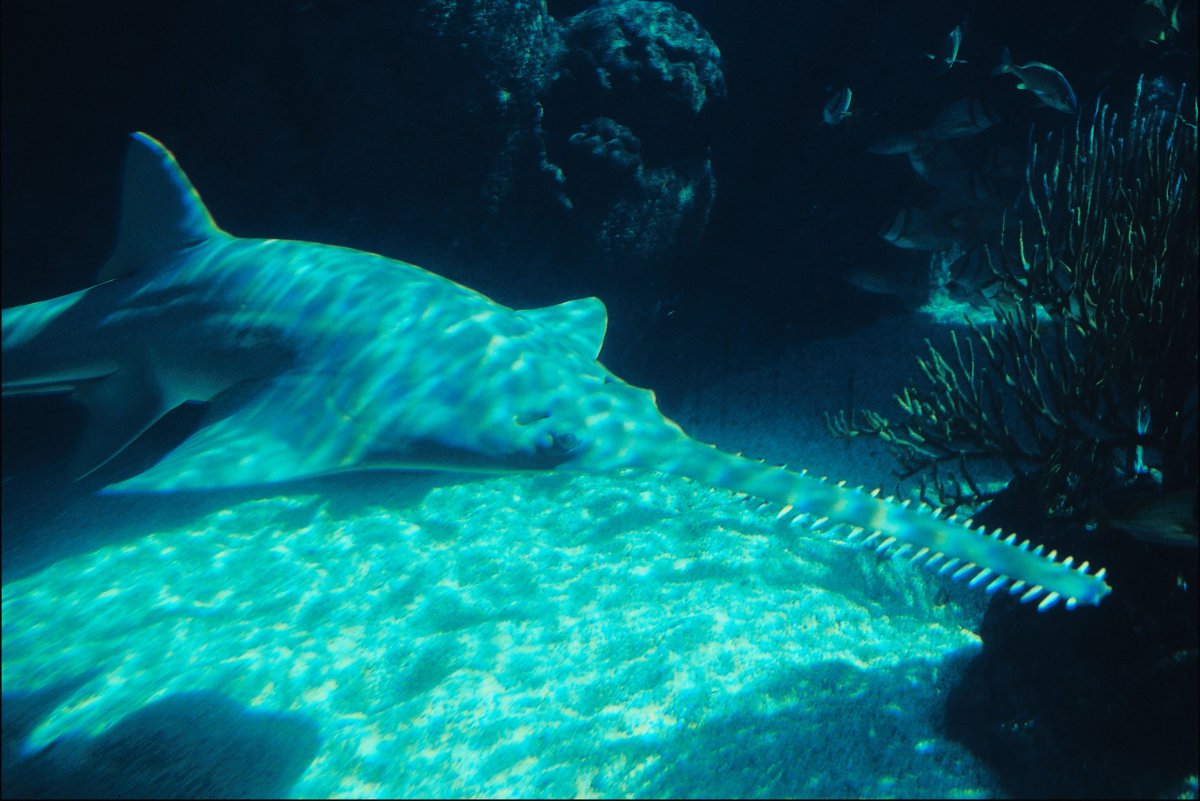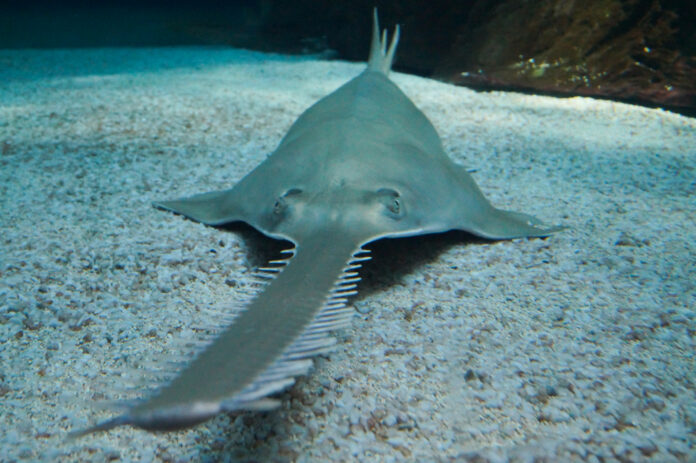Critically endangered sawfish keep washing up dead and dying in the Florida Keys, mystifying scientists.
In the past few months, 20 of the rare fish have been collected for research after being found dead on the shores, with over 60 others having been spotted bizarrely thrashing in the shallows, seemingly in the throes of death.
The cause of this spate of deaths has baffled scientists, with suggested explanations ranging from toxic algae to increased ocean temperatures.
ISTOCK / GETTY IMAGES PLUS
There are five species of sawfish in the world, the smalltooth sawfish being the only one native to U.S. waters. These fish are characterized by its long, flattened snout covered in sharp teeth-like structures on each side, known as a rostrum, and can grow up to 16 feet in length.
The U.S. southeast used to regularly see these fish, but they are now only found in small areas of Florida, and are listed as “critically endangered” worldwide by the International Union for Conservation of Nature Red List, and “endangered” under the U.S. Endangered Species Act.
The major threats facing this species include the destruction and degradation of their crucial nursery areas such as mangroves and estuaries, being caught unintentionally as bycatch in fishing gear or deliberately for their saw-like rostrum for use in illegal trade and traditional medicine, and pollution, particularly from agricultural runoff and industrial waste. The current U.S. population is thought to be only 5 percent of the size it was at the time of European settlement. There are only around a few thousand left in the wild.
These fish have been seen behaving strangely around the shores of the Keys since around November 2023, where they were increasingly spotted thrashing around and swimming in circles. This behavior has never before been seen in these species, mystifying researchers.
“They should not be swimming in circles. They should not be coming that close to the shore. And certainly there’s no reason for their rostrum to be out of the water,” Dean Grubbs, a Florida State University fish ecologist and member of the National Oceanic and Atmospheric Administration’s sawfish recovery team, told local news WLRN.
Additionally, according to tracking data, sawfish are usually found in deeper waters of 100 to 200 feet, rather than right next to the shore.
The fish then began to be found dead on beaches, with 20 being found so far. The researchers think that this may be an underestimate of the total number that have died.
“I do think we’re probably underestimating the number here in terms of figuring it out,” Grubbs said. “It’s puzzling to me, too, that there’d be so many sawfish compared to other species. It doesn’t make a lot of sense to me.”
The 20 specimens of these dead endangered fish have been examined by researchers, but testing of their bodies has not yet provided answers to their mysterious deaths. Traces of toxins were found in their bodies, as well as a dinoflagellate algae known as gambierdiscus. Additionally, water testing near the Keys found increased levels of gambierdiscus.

ISTOCK / GETTY IMAGES PLUS
Gambierdiscus is known to cause a condition called ciguatera fish poisoning, or simply ciguatera, in humans. This occurs as a result of fish eating the algae, and then people eating the fish and the toxins produced by the algae. Around 50,000 people get sick from the condition every year, with symptoms including diarrhea, vomiting, dizziness, and weakness.
However, fish have never been known to get sick from these algal toxins, meaning that the gambierdiscus may not be the true culprit of these sawfish deaths.
“We didn’t find a smoking gun. That doesn’t mean it’s not buried somewhere. But it’s not as easy as some of us were hoping it would be,” Mike Parsons, an algae expert at Florida Gulf Coast University and a member of the state’s Blue Green Algae Task Force, told WLRN.
Another suggestion of what might be driving these mysterious deaths is increased ocean temperatures: an ocean heatwave caused a temperature spike of 5 degrees in some waters off the Keys last summer, bleaching coral.
“The system that’s impacted here in the Lower Keys is a very resilient ecosystem system that has endured a lot of change,” said Martin Grossell, a fish ecologist at the University of Miami Rosenstiel School who specializes in how fish work and the toxins that harm them.
Increased ocean temperatures, combined with other factors like sewage pollution and other chemicals in the water, may trigger changes in the marine ecosystem that are affecting the sawfish in ways we don’t yet understand.
“We are adding to this environment and eventually may reach a threshold where now this balance is perturbed,” Grossell told WLRN. “Then you start seeing things that you haven’t seen before and things that we have a hard time explaining.”
Do you have a tip on a science story that Newsweek should be covering? Do you have a question about smalltooth sawfish? Let us know via [email protected].
Uncommon Knowledge
Newsweek is committed to challenging conventional wisdom and finding connections in the search for common ground.
Newsweek is committed to challenging conventional wisdom and finding connections in the search for common ground.


